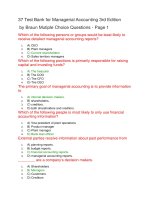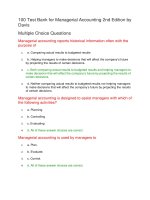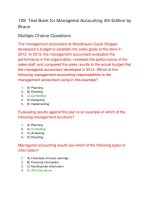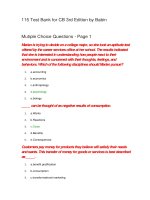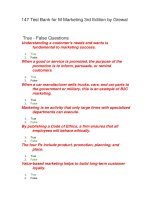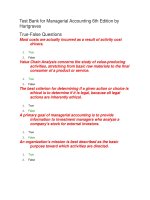Test bank for managerial accounting 3rd edition by wild
Bạn đang xem bản rút gọn của tài liệu. Xem và tải ngay bản đầy đủ của tài liệu tại đây (1.72 MB, 158 trang )
Full file at />
Chapter 01
Managerial Accounting Concepts and Principles
True / False Questions
1. Much of managerial accounting is directed at gathering useful information about costs for
planning and control decisions.
True False
2. Control is the process of setting goals and determining ways to achieve them.
True False
3. Managerial accounting is an activity that provides financial and nonfinancial information to
an organization's managers and other internal decision makers.
True False
4. One of the usual differences between financial and managerial accounting is the time
dimension of the information reported.
True False
5. Managerial accounting information can be forwarded to the managers of a company
quickly since external auditors do not have to review it, and estimates and projections are
acceptable.
True False
6. One difference between financial and managerial accounting is that the external users that
use financial information must plan a company's future, but the internal users of managerial
accounting information generally must decide whether to invest in or lend to a company.
True False
buy this full document at
Full file at />
7. Financial accounting relies on accepted principles that are enforced through an extensive
set of rules and guidelines; on the other hand, managerial accounting systems are flexible.
True False
8. The focus of financial accounting is on an organization's projects, processes, and
subdivisions, and the focus of managerial accounting is on the whole organization.
True False
9. Both financial and managerial accounting report monetary information; managerial
accounting also reports considerable nonmonetary information.
True False
10. Both financial and managerial accounting affect people's decisions and actions.
True False
11. The concept of total quality management focuses on continuous improvement.
True False
12. The orientation of just-in-time manufacturing is that products are "pulled" through the
manufacturing process by the orders received from customers.
True False
13. When the attitude of continuous improvement exists throughout an organization, every
manager and employee seeks to continuously experiment with new and improved business
practices.
True False
buy this full document at
Full file at />
14. The main principle of the lean business model is the elimination of waste of every kind
while satisfying the customer and providing a positive return to the company.
True False
15. The management concept of customer orientation causes a company to spend large
amounts on advertising to convince customers to buy the company's standard products.
True False
16. The management concept of customer orientation encourages a company to set up its
production system to produce large quantities of the same product for all customers.
True False
17. Total quality management and just-in-time manufacturing are two modern systems
designed to improve the quality of management and the products and services offered.
True False
18. Under a just-in-time manufacturing system, large quantities of inventory are accumulated
throughout the factory to be certain that needed components are available each time that they
are needed.
True False
19. The balanced scorecard aids in continuous improvement by augmenting financial
measures with drivers or indicators of future financial performance.
True False
20. The Lean Business Model should have no effect on cost in a modern manufacturing
environment.
True False
buy this full document at
Full file at />
21. Fraud affects all business.
True False
22. Fraud involves the deliberate or accidental misuse of the employer's assets.
True False
23. Direct materials are not usually easily traced to a product.
True False
24. Costs may be classified by many different cost classifications.
True False
25. Product costs can be classified as one of three types: direct materials, direct labor, or
overhead.
True False
26. Whether a cost is controllable or not controllable by an employee depends on the
employee's level of responsibility.
True False
27. Indirect materials are accounted for as factory overhead because they are not easily traced
to specific units or batches of production.
True False
28. A variable cost changes in proportion to changes in the volume in activity.
True False
buy this full document at
Full file at />
29. Direct costs are incurred for the benefit of more than one cost object.
True False
30. A sunk cost has already been incurred and cannot be avoided or changed, so it is irrelevant
to decision making.
True False
31. An out-of-pocket cost requires a future cash outlay and is relevant for decision making.
True False
32. An opportunity cost requires a future cash outlay and is relevant for decision making.
True False
33. Period costs are incurred by purchasing merchandise or manufacturing finished goods.
True False
34. Product costs are expenditures necessary and integral to finished products.
True False
35. Cost concepts such as variable, fixed, mixed, direct and indirect apply only to
manufacturers and not to service companies.
True False
36. Although direct labor and raw materials costs are treated as manufacturing costs and
therefore make up part of the finished goods inventory cost, factory overhead is charged to
expense as it is incurred because it is a period cost.
True False
buy this full document at
Full file at />
37. Selling and administrative expenses are normally product costs.
True False
38. The cost of partially completed products is included in the balance of the Goods in
Process Inventory account.
True False
39. Raw materials that become part of a product and are identified with specific units or
batches of a product are called direct materials.
True False
40. Manufacturers usually have three inventories: raw materials, goods in process, and
finished goods.
True False
41. Raw materials inventory includes only direct materials.
True False
42. The Goods in Process Inventory account is found only in the ledgers of merchandising
companies.
True False
43. The main difference between the income statement of a manufacturer and a merchandiser
is that the merchandiser includes cost of goods manufactured rather than cost of goods
purchased.
True False
buy this full document at
Full file at />
44. Raw materials purchased plus beginning raw materials inventory equals the ending
balance of raw materials inventory.
True False
45. Four factors come together in the manufacturing process: beginning goods in process
inventory, direct materials, direct labor, and factory overhead.
True False
46. Newly completed units are combined with beginning finished goods inventory to make up
total ending goods in process inventory.
True False
47. The series of activities that add value to a company's products or services is called a value
chain.
True False
48. Cycle time equals process time plus inspection time plus move time plus wait time.
True False
49. A manufacturer's cost of goods manufactured is the sum of direct materials, direct labor,
and factory overhead costs incurred in producing products.
True False
50. Indirect labor refers to the cost of the workers whose efforts are directly traceable to
specific units or batches of product.
True False
buy this full document at
Full file at />
51. Factory overhead includes selling and administrative expenses because they are indirect
costs of a product.
True False
52. Prime costs consist of direct labor and factory overhead.
True False
53. The manufacturing statement is also known as the schedule of manufacturing activities or
the schedule of cost of goods manufactured.
True False
54. The manufacturing statement must be prepared monthly as it is a required general-purpose
financial statement.
True False
Multiple Choice Questions
55. Managerial accounting information:
A. Is used mainly by external users.
B. Involves gathering information about costs for planning and control decisions.
C. Is generally the only accounting information available to managers.
D. Can be used for control purposes but not for planning purposes.
E. Has little to do with controlling costs.
buy this full document at
Full file at />
56. Managerial accounting is different from financial accounting in that:
A. Managerial accounting is more focused on the organization as a whole and financial
accounting is more focused on subdivisions of the organization.
B. Managerial accounting never includes nonmonetary information.
C. Managerial accounting includes many projections and estimates whereas financial
accounting has a minimum of predictions.
D. Managerial accounting is used extensively by investors, whereas financial accounting is
used only by creditors.
E. Managerial accounting is mainly used to set stock prices.
57. Flexibility of practice when applied to managerial accounting means that:
A. The information must be presented in electronic format so that it is easily changed.
B. Managers must be willing to accept the information as the accountants present it to them,
rather than in the format they ask for.
C. The managerial accountants need to be on call twenty-four hours a day.
D. The design of a company's managerial accounting system largely depends on the nature of
the business and the arrangement of the internal operations of the company.
E. Managers must be flexible with information provided in varying forms and using
inconsistent measures.
58. Which of the following items does not represent a difference between financial and
managerial accounting?
A. Users of the information.
B. Flexibility of practices.
C. Timeliness and time dimension of the information reported.
D. Nature of the information.
E. Purpose of accounting.
59. Which of the following items is a management concept that was not created to improve
companies' performances?
A. Just-in-time manufacturing.
B. Customer orientation.
C. Total quality management.
D. Continuous improvement.
E. Theory of Constraints.
buy this full document at
Full file at />
60. The Malcolm Baldridge Award was established by:
A. The United Nations.
B. The U. S. Chamber of Commerce.
C. The Malcolm Baldridge Foundation.
D. The U. S. Congress.
E. The SEC.
61. Continuous improvement:
A. Is a measure of profits.
B. Is a measure of costs.
C. Rejects the notion of "good enough."
D. Is not applicable to most businesses.
E. Is possible only in service businesses.
62. An attitude of constantly seeking ways to improve company operations, including
customer service, product quality, product features, the production process, and employee
interactions, is called:
A. Continuous improvement.
B. Customer orientation.
C. Just-in-time.
D. Theory of constraints.
E. Total quality measurement.
63. A management concept that encourages all managers and employees to be in tune with the
wants and needs of customers, and which leads to flexible product designs and production
processes, is called:
A. Continuous improvement.
B. Customer orientation.
C. Just-in-time.
D. Theory of constraints.
E. Total quality management.
buy this full document at
Full file at />
64. An approach to managing inventories and production operations such that units of
materials and products are obtained and provided only as they are needed is called:
A. Continuous improvement.
B. Customer orientation.
C. Just-in-time manufacturing.
D. Theory of constraints.
E. Total quality management.
65. A management concept that applies quality improvement to all aspects of business
activities is called:
A. Continuous operations.
B. Customer orientation.
C. Just-in-time.
D. Theory of constraints.
E. Total quality management.
66. The model whose goal is to eliminate waste while satisfying the customer and providing a
positive return to the company is:
A. Total quality management.
B. Managerial accounting.
C. Customer orientation.
D. Continuous improvement.
E. Lean business model.
67. Which of the following is not a characteristic of all fraud?
A. It is done to provide direct or indirect benefit to the employee.
B. It violates the employee's duties to his employer.
C. It costs the employer money.
D. It is secret.
E. Can be intentional or unintentional.
buy this full document at
Full file at />
68. Which of the following statements regarding fraud is (are) true?
A. Fraud is a deliberate act.
B. Fraud can be deliberate or unintentional; the outcome of the act determines if fraud exists.
C. A company with a strong code of ethics can eliminate fraud.
D. A company with strong internal controls can eliminate fraud.
E. The most common type of fraud is financial statement fraud.
69. Which of the following statements is true?
A. The IMA's Statement of Ethical Professional Practice requires management accountants to
be incompetent, maintain confidentiality, act with integrity, and communicate information in a
fair and credible manner.
B. The IMA's Statement of Ethical Professional Practice requires management accountants to
be competent, maintain confidentiality, eliminate all fraud, and communicate information in a
fair and credible manner.
C. The IMA's Statement of Ethical Professional Practice requires management accountants to
be incompetent, maintain confidentiality, act with integrity, and miscommunicate information
in a credible manner.
D. The IMA's Statement of Ethical Professional Practice requires management accountants to
be competent, maintain confidentiality, act with integrity, and communicate information in a
fair and credible manner.
E. The IMA's Statement of Ethical Professional Practice requires management accountants to
perform certain checks for fraud, act with integrity, and communicate information in a fair
and credible manner.
70. The Institute of Management Accountants has developed a code of ethics which requires
management accountants to behave in certain ways. Which of the following behaviors is not
required?
A. Competence
B. Integrity
C. Maintenance of confidentiality
D. Communication of information in credible manner
E. Timeliness
buy this full document at
Full file at />
71. A direct cost is a cost that is:
A. Identifiable as controllable.
B. Variable with respect to the volume of activity.
C. Fixed with respect to the volume of activity.
D. Traceable to a cost object.
E. Sunk with respect to a cost object.
72. An opportunity cost is:
A. An uncontrollable cost.
B. A cost of potential benefit lost.
C. A change in the cost of a component.
D. A direct cost.
E. A sunk cost.
73. Labor costs that are clearly associated with specific units or batches of product because
the labor is used to convert raw materials into finished products called are:
A. Sunk labor.
B. Direct labor.
C. Indirect labor.
D. Finished labor.
E. Supervisory labor.
74. Costs that are incurred as part of the manufacturing process but are not clearly associated
with specific units of product or batches of production, including all manufacturing costs
other than direct material and direct labor costs, are called:
A. Administrative expenses.
B. Nonmanufacturing costs.
C. Sunk costs.
D. Factory overhead.
E. Preproduction costs.
buy this full document at
Full file at />
75. Materials that are used in support of the production process but that do not become a part
of the product and are not clearly identified with units or batches of product are called:
A. Secondary materials.
B. General materials.
C. Direct materials.
D. Indirect materials.
E. Materials inventory.
76. The salary paid to the supervisor of an assembly line would normally be classified as:
A. Direct labor.
B. Indirect labor.
C. A period cost.
D. A general cost.
E. An assembly cost.
77. Classifying costs by behavior involves:
A. Identifying fixed cost and variable cost.
B. Identifying cost of goods sold and operating costs.
C. Identifying all costs.
D. Identifying costs in a physical manner.
E. Identifying both quantitative and qualitative cost factors.
78. Costs classified by controllability are useful for:
A. The balance sheet.
B. The income statement.
C. The budgeting process.
D. Evaluation reports.
E. Determining product cost.
buy this full document at
Full file at />
79. Which of the following is never included in direct materials costs?
A. Invoice costs of direct materials.
B. Outgoing delivery charges.
C. Materials storage costs.
D. Materials handling costs.
E. Insurance on stored material.
80. Raw materials that physically become part of the product and can be traced to specific
units or batches of product are called:
A. Raw materials sold.
B. Chargeable materials.
C. Goods in process.
D. Indirect materials.
E. Direct materials.
81. The following costs are included in a recent summary of data for a company: advertising
expense $85,000; depreciation expense - factory building $133,000; direct labor $250,000;
direct material used $300,000; factory utilities $105,000; and sales salaries expense $150,000.
Determine the dollar amount of prime costs.
A. $1,023,000
B. $550,000
C. $488,000
D. $235,000
E. $238,000
82. The following costs are included in a recent summary of data for a company: advertising
expense $85,000; depreciation expense - factory building $133,000; direct labor $250,000;
direct material used $300,000; factory utilities $105,000; and sales salaries expense $150,000.
Determine the dollar amount of conversion costs.
A. $1,023,000
B. $550,000
C. $488,000
D. $235,000
E. $238,000
buy this full document at
Full file at />
83. A mixed cost:
A. Requires the future outlay of cash and is relevant for future decision making.
B. Does not change with changes in the volume of activity within the relevant range.
C. Is directly traceable to a cost object.
D. Contains a combination of fixed costs and variable costs.
E. Has already been incurred and cannot be avoided so it is irrelevant for decision making.
84. A fixed cost:
A. Requires the future outlay of cash and is relevant for future decision making.
B. Does not change with changes in the volume of activity within the relevant range.
C. Is directly traceable to a cost object.
D. Changes with changes in the volume of activity within the relevant range.
E. Has already been incurred and cannot be avoided so it is irrelevant for decision making.
85. Which of the following costs is not included in factory overhead?
A. Payroll taxes on the wages of supervisory factory workers.
B. Indirect labor.
C. Depreciation of manufacturing equipment.
D. Manufacturing supplies used.
E. Direct materials.
86. The three major cost components of a manufactured product are:
A. Marketing, selling, and administrative costs.
B. Indirect labor, indirect materials, and miscellaneous factory expenses.
C. Direct materials, direct labor, and factory overhead.
D. Differential costs, opportunity costs, and sunk costs.
E. General, selling, and administrative costs.
87. Which of the following costs would not be classified as factory overhead?
A. Property taxes on maintenance machinery.
B. Expired insurance on factory equipment.
C. Wages of the factory janitor.
D. Metal doorknobs used on wood cabinets produced.
E. Small tools used in production.
buy this full document at
Full file at />
88. Period costs for a manufacturing company would flow directly to:
A. The current income statement.
B. Factory overhead.
C. The current balance sheet.
D. Job cost sheet.
E. The current manufacturing statement.
89. Costs that are first assigned to inventory are called:
A. Period costs.
B. Product costs.
C. General costs.
D. Administrative costs.
E. Fixed costs.
90. Costs that flow directly to the current income statement are called:
A. Period costs.
B. Product costs.
C. General costs.
D. Balance sheet costs.
E. Capitalized costs.
91. Product costs:
A. Are expenditures necessary and integral to finished products.
B. Are expenditures identified more with a time period rather than with finished products.
C. Include selling and administrative expenses.
D. Are costs that vary with the volume of activity.
E. Are costs that do not vary with the volume of activity.
buy this full document at
Full file at />
92. The following are all examples of product costs:
A. Direct material, Direct Labor and Indirect Labor.
B. Direct Labor, VP of Sales salary, and Insurance on the factory.
C. Depreciation on the factory equipment, depreciation on the office building, and
depreciation on the factory building.
D. Factory Insurance, Interest expense, and Property taxes on the factory.
E. Office supplies, Sales commissions, and maintenance costs on office copier.
93. Products that have been completed and are ready to be sold by the manufacturer are
called:
A. Finished goods inventory.
B. Goods in process inventory.
C. Raw materials inventory.
D. Cost of goods sold.
E. Factory supplies.
94. Goods a company acquires to use in making products are called:
A. Cost of goods sold.
B. Raw materials inventory.
C. Finished goods inventory.
D. Goods in process inventory.
E. Conversion costs.
95. Products that are in the process of being manufactured but are not yet complete are
called:
A. Raw materials inventory.
B. Conversion costs.
C. Cost of goods sold.
D. Goods in process inventory.
E. Finished goods inventory.
buy this full document at
Full file at />
96. Another title for goods in process inventory is:
A. Indirect materials inventory.
B. Work in process inventory.
C. Conversion costs.
D. Direct materials inventory.
E. Raw materials inventory.
97. Cycle time is:
A. Value added time.
B. Process time plus inspection time.
C. Process time plus inspection time plus move time.
D. Process time plus inspection time plus move time plus wait time.
E. Another name for cycle efficiency.
98. Cycle efficiency:
A. Is the ratio of value-added time to total cycle time.
B. Is the ratio of value-added time to non-value-added time.
C. Is the ratio of process time to total cycle time.
D. Cannot be used in conjunction with other analytical tools.
E. Is the same as the cycle time.
99. A company produces work boots. The company received and produced an order for 3,000
pairs of boots. The following information is available regarding this order.
What is this company's manufacturing cycle efficiency?
A. 22 days.
B. 5.5 days
C. 22.27%
D. 15%
E. 21.4%
buy this full document at
Full file at />
100. Companies A, B, C and D are competitors in the same industry. Recently each received
and produced an order for 75,000 units of an identical item. The following times were
measured at each company.
Which of the following statements is true regarding the manufacturing cycle efficiency of
these companies?
A. Company A was the least efficient.
B. Company D was the most efficient.
C. Company B was the least efficient.
D. Company C was the most efficient.
E. Company A was the most efficient.
101. The cost of labor that is not clearly associated with specific units or batches of product is
called:
A. Unspecified labor.
B. Direct labor.
C. Indirect labor.
D. Basic labor.
E. Joint labor.
102. Factory overhead costs normally include all of the following except:
A. Indirect labor costs.
B. Indirect material costs.
C. Selling costs.
D. Machinery oil.
E. Factory rent.
buy this full document at
Full file at />
103. The following costs are included in a recent summary of data for a company: advertising
expense $85,000; depreciation expense - factory building $133,000; direct labor $250,000;
direct material used $300,000; factory utilities $105,000; and sales salaries expense $150,000.
Determine the dollar amount of overhead costs.
A. $1,023,000
B. $550,000
C. $488,000
D. $235,000
E. $238,000
104. Which of the following items appears only in a manufacturing company's financial
statements?
A. Cost of goods sold.
B. Cost of goods manufactured.
C. Goods available for sale.
D. Gross profit.
E. Net income.
105. The total cost of goods completed during the accounting period for a manufacturer is
called:
A. Ending finished goods inventory.
B. Total manufacturing costs.
C. Ending goods in process inventory.
D. Cost of goods manufactured.
E. Cost of goods sold.
106. A manufacturing firm's cost of goods manufactured is equivalent to a merchandising
firm's:
A. Cost of goods sold.
B. Cost of goods purchased.
C. Cost of goods available.
D. Beginning merchandise inventory.
E. Ending merchandise inventory.
buy this full document at
Full file at />
107. Which one of the following items is normally not a manufacturing cost?
A. Direct materials.
B. Factory overhead.
C. General and administrative expenses.
D. Direct labor.
E. Conversion cost.
108. Juliet Corporation has accumulated the following accounting data for the year:
The cost of goods manufactured for the year is:
A. $200
B. $1,000
C. $5,000
D. $6,400
E. $8,200
109. A manufacturing company has a beginning finished goods inventory of $14,600, raw
material purchases of $18,000, cost of goods manufactured of $32,500, and an ending finished
goods inventory of $17,800. The cost of goods sold for this company is:
A. $21,200
B. $29,300
C. $32,500
D. $47,100
E. $27,600
110. The beginning and ending finished goods inventories of the Prize Ring manufacturing
company were $75,000 and $73,000 respectively. If cost of goods sold equaled $66,000, what
is the amount of cost of goods manufactured for this period?
A. $2,000
B. $64,000
C. $68,000
D. $82,000
E. $214,000
buy this full document at
Full file at />
111. Compute cost of goods manufactured for this period given the following amounts.
A. $72,000
B. $48,000
C. $60,000
D. $66,000
E. $180,000.
112. The beginning and ending finished goods inventories of a company were $91,000 and
$94,000 respectively. If cost of goods sold equaled $800,000, what is the amount of cost of
goods manufactured for this period?
A. $706,000
B. $709,000
C. $797,000
D. $803,000
E. $3,000
113. A manufacturing statement is also known as a schedule or listing of the:
A. Raw materials processed.
B. Factory supplies used.
C. Cost of goods manufactured.
D. Total finished goods.
E. Cost of goods sold.
buy this full document at
Full file at />
114. The following information relates to the manufacturing operations of the IMH Publishing
Corporation for the year:
The raw materials used in manufacturing during the year totaled $118,000. Raw materials
purchased during the year amount to:
A. $107,000
B. $115,000
C. $118,000
D. $121,000
E. $126,000
115. Ajax Company accumulated the following account information for the year:
Using the above information, total factory overhead costs would be:
A. $9,800
B. $16,800
C. $15,800
D. $13,000
E. $7,800
buy this full document at
Full file at />
116. The following information is available for the year ended December 31:
The amount of raw materials used in production for the year is:
A. $4,100
B. $5,100
C. $3,500
D. $6,500
E. $4,000
117. A financial report that summarizes the amounts and types of costs that were incurred in
the manufacturing process during the period is a:
A. Materiality statement.
B. Managerial statement.
C. Manufacturing statement.
D. Merchandise statement.
E. Monetary statement.
118. Which of the following accounts would all appear on a manufacturing statement?
A. Raw materials, factory insurance expired, indirect labor.
B. Raw materials, goods in process, finished goods.
C. Factory buildings, delivery equipment, and depreciation on factory equipment.
D. Direct labor, indirect labor, sales salaries.
E. Direct labor, factory repairs and maintenance, wages payable.
Use the following information from Hardy Co. for the current year:
buy this full document at

